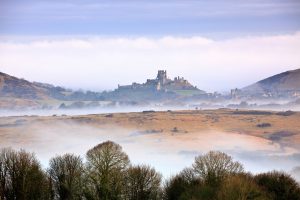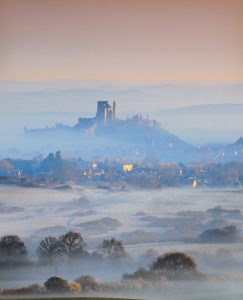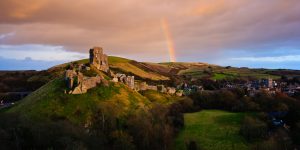Corfe Castle was built by William the Conqueror to defend the only gap in the Purbeck Hills for eleven miles. This imposing structure must have struck terror into the hearts of any attacking army. The castle finally fell during the English Civil War when a group of Parliamentarians entered with their coats worn inside-out so that they resembled Royalists. Once inside, they turned their coats the correct way and there began a simultaneous attack from outside and within. This event is supposedly the origin of the phrase ‘turncoat’. Later that year, Parliament voted to demolish the castle, resulting in its ruined appearance today.
How To Get Here
From Wareham, follow the A351 towards Corfe Castle. The National Trust visitor centre and car park is just past the 30mph sign on the left. Alternatively, almost opposite the visitor centre, you can turn right into Tyneham Road, where there is a large lay-by on the right.
Parking
- Parking Lat/Long: 50.642057, -2.058855
- Parking Postcode: BH20 5DR
- Parking OS map co-ordinate: SY 959 824
- Map: OS Explorer Map OL15 (1:25 000) Purbeck and South Dorset
What To Shoot and Viewpoints
Parliament did modern photographers a great favour; the romantic ruin probably photographs better than any perfectly-preserved castle, especially on misty mornings when the ruins rise above the top layer of mist like a scene from a fantasy lm. It’s not obligatory to shoot it in these conditions, though this seems to be the shot that everyone wants to get. The classic viewpoint is from West Hill but if you want your shots to stand out from the crowd there are other high vantage points you can explore.
- VP3. Corfe Castle from Kingston. Canon 5D II, 70-200mm f/4 at 145mm, ISO 200, 1/80 sec at f/8. © Mark Bauer
- VP3. The castle, viewed from across Corfe Common Canon 5D II, 70-200mm f/4 at 200mm, ISO 100, 1/8 sec at f/16. © Mark Bauer
- Late afternoon in autumn from West Hill (Viewpoint 2). Canon 5D II, 24-105mm f/4 at 31mm, ISO 100, 2.5 secs at f/22. © Mark Bauer
Viewpoint 1 – West Hill
From the National Trust car park on the A351, cross the road and near the junction with Tyneham Road, go through a gate into a field. Cross the field, passing a barn on your left and go through a gate on the far side. Follow the footpath up West Hill. It’s a steep climb, but how far up you go is entirely up to you – there are good viewpoints from quite low down. If there is a mist, you may need to climb quite far to get above it, and mist behind the castle should help it to stand out from the background. Lower down the hill, the castle will break the horizon, thus being separated from the background, and this can be a better option if there is no mist behind the castle.
Viewpoint 2 – West Hill from the other side
Alternatively, drive or walk along Tyneham Road for a couple of hundred metres. There is a lay-by on the left, just past the bridge and almost opposite this there is a gate through to the hill. A set of steps is carved into the hill, but although it’s slightly easier underfoot, it’s just as steep a climb. This alternative viewpoint works very well later in the day, when attractive side-lighting can hit the castle.
Viewpoint 3 – From Kingston
Drive through Corfe Castle towards Swanage, and turn right immediately after leaving the village. Drive up the hill and turn right into Kingston at the Scott Arms pub. Park (legally and considerately) in the village then walk out of the village towards Swanage, east on the B3069. Just past a converted church on the left, climb over a stile into a eld. Follow the footpath for 20 or 30 metres and there are panoramic views across Corfe Common towards the castle. A 70-200mm lens is recommended for this viewpoint, which shows the castle commanding the gap in the hills.
Accessibility
From the car park to the foot of West Hill is 250m. It’s a steep climb up to the top and you may want to pause for breath along the way. There’s no need to climb all the way to the top as there are good views from various points lower down. There is no wheelchair access. Kingston is a short drive from Corfe Castle and the viewpoint is a short, easy walk from the village. An alternative is to shoot it from the beer garden of the Scott Arms – wheelchair access is possible. The viewpoint across the Common is about 2 km from Kingston, it is an easy walk along the footpath, but not wheelchair-friendly..
Best Time of Year/Day
Corfe Castle photographs well at any time of year, but for mist, spring and early autumn – especially April and late September are best. Depending on the conditions, mist can occur at any time of year, so don’t write off the summer months. Whilst it looks good at any time of day, it is at its most atmospheric first thing in the morning.




